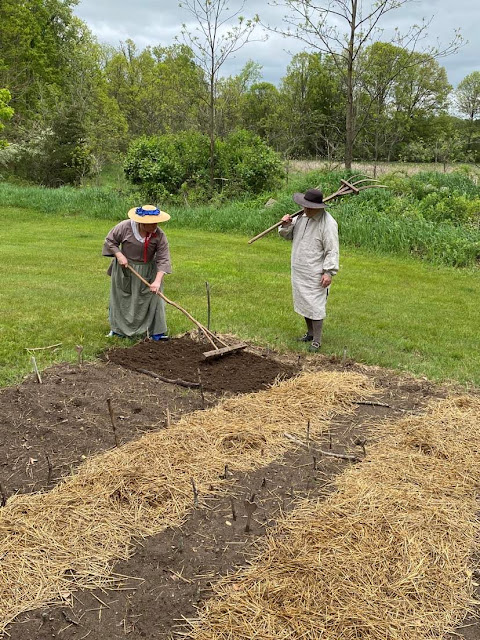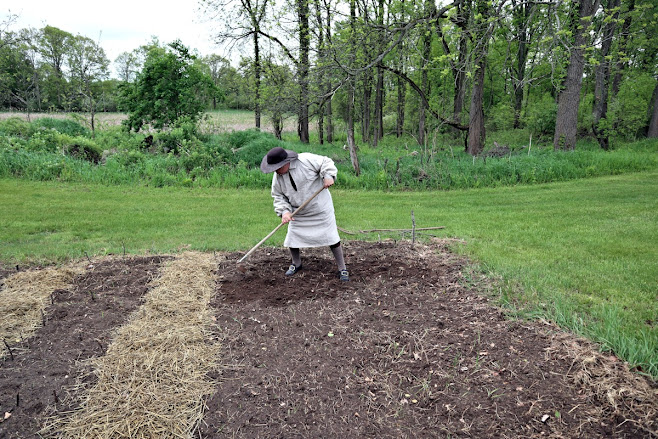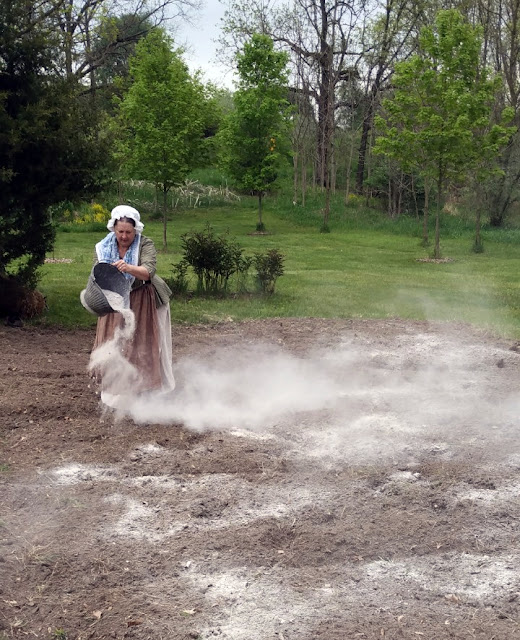Do you think you could live "back then"?
Lots of people believe they could, but I know for a fact it would be extremely difficult for most modern persons to attempt to survive in the past.
~~~
Here are photos and commentary on the 18th century gardening that my wife Patty and I did at the cabin located at Waterloo Farm.
..................................................
For this we have a sort of "part 2" of the posting immediately previous to this one (click HERE if that will help), for you will see us at the frontier cabin doing spring chores, including planting. Unfortunately, we don't really live at the cabin and therefore are not there daily to ensure all the work that needs doing gets done! So here we are a week later, my wife Patty & I, back at the Waterloo cabin, completing what was not able to get completed the previous week!
This posting fits in with ancient farming, for pretty much the same tools and techniques are being utilized.
Back to 1773 we go - - - - - - - - - - - - -
 |
| My hay rake (which I also use in the garden) and my regular wood rake, which does a very good job in clearing & cleaning up the garden bed. |
 |
| Here's Patty and I doing a sort of imitation of American Gothic. Yes, we plan to dress in our period clothing anytime we go out to work in this garden. For the first time, I am wearing and working in my new farmer's linen work smock I purchased from Townsends. But, to me it just keeps the whole thing period authentic. Yes, I suppose I am a bit off center! lol |
 |
| Patty & Charlotte did a fine job planting the week before. But there was a couple patches they were not able to get to. |
 |
| I did prepare about a third of the garden patch in total, including raking and hoeing, and then I did some sowing (beans!) as I continued getting rid of hiding clumps of rooted grass and weeds as I dropped the seeds into the holes. Not bad for being in pain, eh? |
 |
| When Patty and I first began to date, way back in 1982, we spoke on gardening, on farming, on how people lived in the old days, and how we would had loved to live "back then." Well, in a way, this is that dream come true - with (hopefully) more to come. |
 |
| Meanwhile, Patty sowed a variety of items, adding to what was already planted there the week before. |
 |
| Besides the beans, we have beets, onions, squash, beans, cucumbers, turnips, carrots, and even a few pumpkins. |
 |
| Patty using the replicated 18th century watering jug for watering the seeds. They've been using this watering jug for years at the Daggett House at Greenfield Village. I then saw one very similar to what I have here being used on one of the British-made farm documentaries - either Tudor Farm or Tales From the Green Valley (1620) farm. So...I had to have one as well! God willing, we shall have a fine harvest in 70 to 90 or so days.And there are a few that will be ready come fall.  |
 |
| You'll note my "broken in" smock. Kneeling in the dirt to sow. My wife's apron, which was also worn, in part, to keep her skirt clean, has seen cleaner days as well. Patty & I plan to try to come out two to three times a month on our own to weed and to make sure all is well. My wife has been getting into gardening big time this year and can't seem to get enough. She certainly does have a green thumb! |
 |
| Because of my ache-r (back) I did go inside the cabin for a short while to get off my feet to let the nerves in my back relax. |
He also reaped the harvest, and as his grandson, so did I...when I was younger...
But now?
Back problems.
When I was a school custodian back in the day, I did a lot of moving, lifting, shifting, carrying, and all other custodial matters, sometimes on a daily basis! I'm sure that was where the root of my back issues began. Yes, I go to physical therapy. Yes, I've been to back doctors (no thanks - no surgery for me!). I've even gone to chiropractors (it's so hard to find a good and trusting one). And, yes, I do the exercises given to me. I'm managing the best I can.
As far as gardening goes, not much has changed from those B.C. and early A.D. eras to the 1770s. Oh, things had certainly improved, but the basics were still the same. However, something that I, as an 18th century farmer/planter should look into: the seed drill invented by none other than Jethro Tull! Though it wasn't until the late 18th century and into the 19th century that it's popularity grew, it was Jethro Tull, an English agriculturalist, who is credited with inventing the first practical seed drill back in 1701, allowing farmers to plant their crop much easier, more uniform, and in tighter rows.
So Mr. Tull did more than sit on a park bench, eh? lol
It wasn't until the later part of the 19th century, after the industrial revolution showed its might, that the real noticeable changes in farming came about. For instance, the reaper: for several centuries, small grains were harvested by hand. But with improvements on the reaper it increased food production as well as made harvesting easier. Farmers could now process more wheat much quicker and with less labor force.
Until next time, see you in time!
 |
That was then---this is now~ Me in my 1860s clothing with my flail / hand thresher. I have no idea of the age of the threshing machine behind me...and neither did the guy who was running it. Definitely new. But my hand-thresher - yeah...that's the old way. |
Thresher. At one time, in order to remove kernels from the straw, grain had to be spread out on a threshing floor where it was beaten by hand. In some cases, animals trampled on the grain to separate it. The invention of the threshing machine made this process much easier.
However, not everyone enjoyed its benefits, for some thought of the threshing machine as "a lazy man's way to thresh. Haste makes waste, but a lazy man'd rather get his work done fast than do it himself. That machine chews up the straw till it's not fit to feed stock, and it scatters grain around and wastes it. All's it saves is time, and what good is time with nothing to do?"
(From Laura Ingalls Wilder book, Farmer Boy)
Steam Engine. The introduction of steam engines improved productivity and technology greatly.
Combine. Reaping, threshing, winnowing – combining all three operations into one led to the invention of the combine harvester, simply known as the combine. Considered one of the most important inventions in agriculture, the combine significantly reduced manpower and sped up the harvesting process.
Tractor. The general-purpose tractor proved to be an excellent replacement for the horse in plowing, soil preparation, planting, and cultivating tasks for a wide variety of field crops. In addition, the tractor was fully capable of providing power for mowing hay and for harvesting of wheat and other small grains.
Hydraulics - moving water through pipes and channels, especially as a source of mechanical force or control.. Hydraulic systems made agricultural production faster and more efficient, while reducing labor costs.
 |
| Your farming family plus the preacher. |
Farming has changed far more over the last 150 to 175 years than since the beginning of agriculture revolution around 10,000 to 12,000 years before. But it's still the same job...only there's machines doing it now.
As far as what our colonial group - Citizens of the American Colonies - are doing: we are making as gallant an attempt to show daily life (and to some extent, live the life) in the same manner as was done 250 years ago. We work. We get dirty. No fancy silks or fear of stains for us, for we are wearing work clothing. That's why I also purchased a linen work smock - to help keep my clothing in better condition, just as a farmer would have done back in the 18th century. But that's why I wear work clothes when I head out to the cabin, with no fear of getting them dirty. And that's why I purchased work clothes for my wife. In fact, all of us wear our work clothes when we are at the cabin.
A real quick aside here:
I purchased the clothing you see my wife in (blue skirt) during the covid break, and she was, like, "okay" - with no excitement in her tone, wondering why I spent the money in this manner, for she was finding herself less and less enchanted with living history. But since we've gotten into this whole period gardening/farming thing, she has thoroughly enjoyed it and has thanked me more than once for purchasing the garments for her.
I love it!
I also love that they are historically accurate! Thank you Samson Historical!
We're often asked where we get our historic clothing from, and, though many of our garments are made by those who can sew or those who can afford a seamstress or tailor, there are a few sutlers where we can purchase what's known as "off-the-rack" clothes. There are two in particular used most often from our members (including my wife's clothes and my smock), and they would be Samson Historical and Townsends, both are highly recommended for purchasing your ready-made items. Plus both have hats, shoes, and "home" accessories, including plates, bowls, silverware, lighting accessories, and so on.
Now, if you prefer to sew your own attire, check out Wm. Booth Draper, as well as Smoke & Fire.
It is our plan, Patty & I, to head out to the cabin and the garden two to three times per month, mostly for weeding. We live quite the distance away and it is a 90 minute drive one way, so we are unable to get out much more than that. If things work right, we should have a decent summer harvest in late July or early August - perhaps in time for Lammas Day!
To read more about farming and tools, click HERE
To read more about A Year on a Colonial Farm, click HERE
To read more about our own living history 19th century harvest, click HERE
To read more about our own living history 18th century harvest, click HERE
To read more about the Time-Life books I mentioned, click HERE
To read an interesting and biblical take on history, please read Discoveries and Inventions: A Biblical History of Man's Developments from Ancient Times
Period Clothing and accessories:
Samson Historical
Samson Historical
and
~ ~
~ ~ ~












































